What's up with Dr. Seuss? Being the first in a series critically examining the works of Thedor Geisel
Today's selection:
One Fish Two Fish Red Fish Blue Fish (1960)
Page Three:
One fish two fish red fish blue fish.
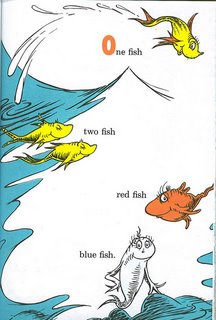

Obviously this shows Seuss' mindset about American individualism. The "one fish" represents America's independent spirit. The red and blue fish, obviously, stand for America's colors, which don't run. But what about the two fish? They are obviously homosexuals, as they show no differences that might be attributed to gender. They might be twins, but their smirky, self-satisfied smiles, and the fact that they are coming from off the page (from an illicit rendezvous?) make it clear what Seuss' real agenda is. America belongs to the queers!
Page Five:
This one has a little car.
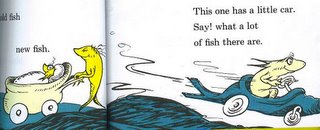

The maniacal look on the fish's face shows Seuss' real thoughts on the march of progress. Seuss is obviously a Luddite, angry that industrialization has infected even the denizens of the deep. The fish is America, selling its soul for a momentary thrill that ultimately will not satisfy. Note that this fish is speeding away from the "new fish" on the previous page - he is obviously the father, and Seuss is decrying the abandonment of the child by its father and the fracturing of the American family - fracturing brought on by the willful and uncomprehending use of technology.
Pages Six & Seven:
Some are sad. And some are glad. And some are very, very bad. Why are they sad and glad and bad? I do not know. Go ask your dad.
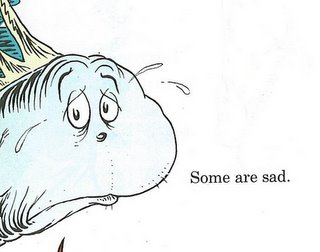

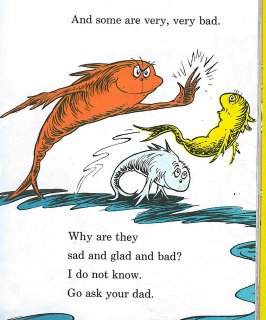

Seuss shows his deep understanding of the volatile and complex socio-political situation of the late 1950s. The "sad" fish is blue. Is this the United States? Not quite, as we shall soon see. The sad fish later conspires with the "very, very bad" fish to push the hapless fish over. The "bad" fish is obviously a representation of the Communist East (either the Soviet Union or China, it does not matter), pushing over the hapless yellow fish, which is, of course, South Vietnam. The blue fish, which was sad, is now smug in his complicity. The sad fish is quite obviously Ho Chi Minh, who came to the West in the 1940s and was rejected in his attempts to gain backing from the democratic powers. With nowhere else to turn, he turned to the Communists. Seuss shows that he recognizes that America failed in this regard - to turn Ho into a staunch supporter of the West - when he tells the audience to "go ask your dad" when they wonder why the fish are sad, glad, or bad. "Your dad" is a rather explicit reference to President Eisenhower, the father figure of the country during its most "domestic" phase - the 1950s. Eisenhower has betrayed Southeast Asia to the Communists, Seuss is saying, and therefore we should demand answers of him.
Pages Eight & Nine:
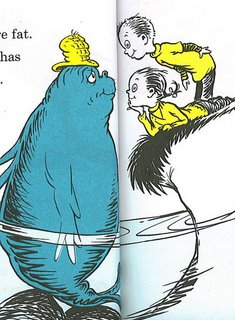

We transition from fish to dry land. Can there be a more clear endorsement of the process of evolution? Seuss is planting in children's mind the thought that we move from the water to the land and evolve from those creatures. Note the almost human-like expression on the fat fish, who is evolved to the point that he is almost a manatee, as he gazes upon the children. Note their adoring gaze back. They are appreciative of the biological sciences that have brought them to this moment, this meeting of humanity's predecessors and its apotheosis. The fact that they are children is no coincidence, either - children are representative of the idyllic state from which we arise.
With the transition from water to land, Seuss takes us into a phantasmagorical land of wildness and, indeed, perversion. Seuss may be pro-American, but exactly what kind of America does he envision? Pages Twelve and Thirteen begin to show us:
Some have two feet and some have four. Some have six feet and some have more. Where do they come from? I can't say. But I bet they have come a long, long way.
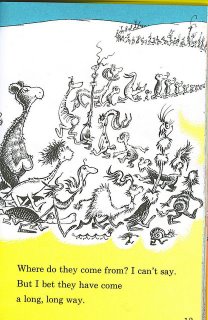

Obviously this is a serious consideration of illegal immigration and its impact on the United States. When the book was published, illegal immigration may not have been in the public eye as much as it is now, but the genius of Geisel was that he could comment on events in the past, present, and future. He is obviously against illegal immigration, but pro-immigration. America will welcome all of you, he is saying, despite your strange ways, but only if you enter in an orderly fashion. No swimming across the Rio Grande for these folk!
Page Fifteen:
Not one of them [immigrants, obviously] is like another. Don't ask us why. Go ask your mother.
The Statue of Liberty, of course. Liberty from the Latin libertas, a feminine noun. Liberty helps us overcome the superficial differences among us and see that we all strive toward freedom.
Page Seventeen:
Say! Look at his fingers! One, two, three ... How many fingers do I see? One, two, three, four, five, six, seven, eight, nine, ten. He has eleven! Eleven! This is something new. I wish I had eleven, too!
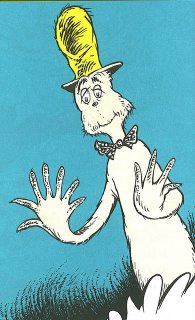

The admiration of those who are different from "the norm" is evident here, just as it was with Seuss' pro-gay statement earlier in the book. The idea that those traditionally seen as "deformed" should be admired is a savage critique of conformity.
With his pro-America and pro-difference stance firmly established, Seuss feels that he can now lead his audience into darker corners. From now on, the book becomes a parade of perversion the likes of which children's literature may never see again. It is almost too much for the rational mind to bear, so I must be brief.
Page Nineteen:
Mr. Gump has a seven hump Wump. So ... if you like to go Bump! Bump! just go jump on the hump of the Wump of Gump.
Self-explanatory, I think.
Page Twenty-One:
And when I pull them in, Oh dear! My head sticks out of bed up here!
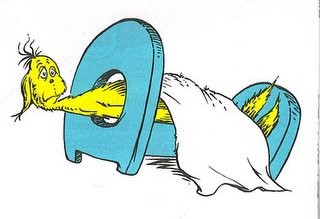

The visual imagery of Ned's "head" penetrating the round hole at the top of his bed makes one shiver with the perversity of it all. Seuss believes that natural, all-American sex is the perverse act, as can be seen by Ned's obvious discomfort with it. What exactly does Seuss suggest as the alternative? Surely it is the orgiastic pleasures of a "seven hump Wump"? Mr. Gump certainly looks satisfied. On Page Twenty-Five, Ned expresses displeasure that a cow, a dog, a cat, and a mouse have joined him in bed.
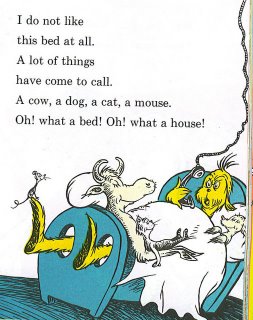
 At least Seuss draws the line at bestiality ...
At least Seuss draws the line at bestiality ...
Or does he? On Pages Twenty-Eight & Twenty-Nine, we see a Bohemian type carrying a bird:
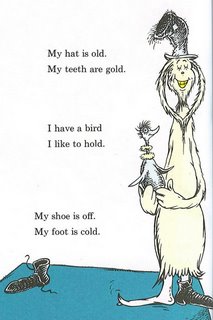
 I have a bird I like to hold.
I have a bird I like to hold.
Both bird and Bohemian look a mite too pleased with themselves. The Bohemian type is also missing a shoe, and his ears form a beard underneath his chin. Seuss is definitely not endorsing a human-fowl relationship here. The Bohemian is a simpleton, repeating his "story" twice with no indication that he remembers telling it the first time, and he is so self-absorbed that he cannot see that his shoe lies just a few feet away, and that his "foot is cold" through his own idiocy. Seuss is very clearly condemning the beatnik culture that was coming into its own in the late 1950s. Of course the Kerouac-worshipping beatniks would have sex with birds!
Pages Thirty-One & Thirty-Two:
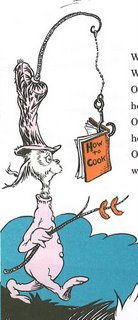

The Nook is an interesting character. He wears a hat with a hook prominently (and phallicly) drooping from it. He also wears a union suit, and we can guess that its ubiquitous back flap is, so to speak, "open for business." The Nook cannot read, so it cannot cook. The symbolism of the Nook is complex and disturbing. On the one hand, the hook connotes sado-masochism, as does the "roasting" of the "weeners." The Nook is a simpleton, but unlike the Bohemian, he is a merry fool, secure in his lack of knowledge and desirous of nothing more. He is not uncomfortable, like the Bohemian and his lack of footwear is. Therefore, we can safely conclude that although Seuss is condemning bestiality, he yet again shows that he is comfortable with perversion among like species. At the same time, the Nook represents more thoughts on immigration. Recall that all of these creatures in the second part of the book are immigrants. The Nook even fits into a specific "nook" in this great land of ours. Seuss is again showing his prescience about today's political hot potato - educating these immigrants who come here and how it is to be done. Educating the Nook would allow him to "cook" - i.e., stop taking food from social services, which is putting a strain on the taxpayers. We can forgive the Nook's perversions, Seuss is saying, but not his lack of basic education. His ignorance is our national tragedy.
Pages Forty-Two & Forty-Three:
We skip ahead a bit, as Seuss allows us, after the majestic symbolism of the Nook, to catch our breath with relatively simplistic images - the sheep (so obvious it's almost unworthy of the master); the loud creature and the quiet creature (and truer depiction of Mideast politics you will never find); the Zans (I don't even think I need to discuss that); the boxing Gox (it's sad that Seuss' comment on contemporary professional sports actually used sports); and the showering Ying (his comment on popular entertainment, however, while incorporating singing, is still more subtle than most). Then he tackles drugs:
This one, I think, is called a Yink. He likes to wink, he likes to drink. He likes to drink, and drink, and drink. The thing he likes to drink is ink.
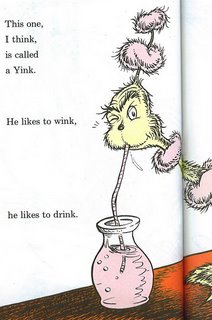

"Drinking" is of course obvious, but the image itself is more subtle than just that. The Yink is surely America, feeding voraciously on the oil ("ink") of the world, and coyly winking while it does so. The addiction of America mirrors the addiction of the Yink to its ink - a drug if there ever was one ("He likes to drink, and drink, and drink" - he is quite clearly no longer in control of his actions). By tying drug addiction to America's addiction on oil and its perverse nature (the "wink" is clearly indicating that the Yink is getting away with something and that others should join in - "It's okay, everybody's doing it!"), Seuss is indicting all of us. We cannot look down on the Yink, because we are implicated in its desires. A powerful statement, indeed.
Like a true disciple of Shakespeare, Seuss does not end his book with its climax. He needs time for a denouement, after all, so the climax of One Fish Two Fish Red Fish Blue Fish comes on Page Fifty-One:
These things are fun and fun is good.
With that simple statement, Seuss makes it clear that he is embracing hedonism in almost all its forms - but a simple, all-American hedonism, one that rejects European styles of sexual activity, with its bird-diddling and such. Real American heroes embrace perversion, but only as long as humans are involved. Such distinctions mean that Seuss recognizes the dynamic sexual urge within us all, and encourages us to explore it, but always remember our morality and mortality.
One Fish Two Fish Red Fish Blue Fish is a complex statement on politics, both national and sexual, as well as immigration and integration into this great land of ours. Seuss stands outside the mainstream and challenges us to accept an America that embraces deviancy and "the other" - all the while remaining loyal to "our dad" - the government that knows all the answers. It stimulates us on a intellectual and visceral level, and as such, remains a classic statement on the American psyche even forty-five years after it first appeared.
One Fish Two Fish Red Fish Blue Fish (1960)
Page Three:
One fish two fish red fish blue fish.


Obviously this shows Seuss' mindset about American individualism. The "one fish" represents America's independent spirit. The red and blue fish, obviously, stand for America's colors, which don't run. But what about the two fish? They are obviously homosexuals, as they show no differences that might be attributed to gender. They might be twins, but their smirky, self-satisfied smiles, and the fact that they are coming from off the page (from an illicit rendezvous?) make it clear what Seuss' real agenda is. America belongs to the queers!
Page Five:
This one has a little car.


The maniacal look on the fish's face shows Seuss' real thoughts on the march of progress. Seuss is obviously a Luddite, angry that industrialization has infected even the denizens of the deep. The fish is America, selling its soul for a momentary thrill that ultimately will not satisfy. Note that this fish is speeding away from the "new fish" on the previous page - he is obviously the father, and Seuss is decrying the abandonment of the child by its father and the fracturing of the American family - fracturing brought on by the willful and uncomprehending use of technology.
Pages Six & Seven:
Some are sad. And some are glad. And some are very, very bad. Why are they sad and glad and bad? I do not know. Go ask your dad.




Seuss shows his deep understanding of the volatile and complex socio-political situation of the late 1950s. The "sad" fish is blue. Is this the United States? Not quite, as we shall soon see. The sad fish later conspires with the "very, very bad" fish to push the hapless fish over. The "bad" fish is obviously a representation of the Communist East (either the Soviet Union or China, it does not matter), pushing over the hapless yellow fish, which is, of course, South Vietnam. The blue fish, which was sad, is now smug in his complicity. The sad fish is quite obviously Ho Chi Minh, who came to the West in the 1940s and was rejected in his attempts to gain backing from the democratic powers. With nowhere else to turn, he turned to the Communists. Seuss shows that he recognizes that America failed in this regard - to turn Ho into a staunch supporter of the West - when he tells the audience to "go ask your dad" when they wonder why the fish are sad, glad, or bad. "Your dad" is a rather explicit reference to President Eisenhower, the father figure of the country during its most "domestic" phase - the 1950s. Eisenhower has betrayed Southeast Asia to the Communists, Seuss is saying, and therefore we should demand answers of him.
Pages Eight & Nine:


We transition from fish to dry land. Can there be a more clear endorsement of the process of evolution? Seuss is planting in children's mind the thought that we move from the water to the land and evolve from those creatures. Note the almost human-like expression on the fat fish, who is evolved to the point that he is almost a manatee, as he gazes upon the children. Note their adoring gaze back. They are appreciative of the biological sciences that have brought them to this moment, this meeting of humanity's predecessors and its apotheosis. The fact that they are children is no coincidence, either - children are representative of the idyllic state from which we arise.
With the transition from water to land, Seuss takes us into a phantasmagorical land of wildness and, indeed, perversion. Seuss may be pro-American, but exactly what kind of America does he envision? Pages Twelve and Thirteen begin to show us:
Some have two feet and some have four. Some have six feet and some have more. Where do they come from? I can't say. But I bet they have come a long, long way.


Obviously this is a serious consideration of illegal immigration and its impact on the United States. When the book was published, illegal immigration may not have been in the public eye as much as it is now, but the genius of Geisel was that he could comment on events in the past, present, and future. He is obviously against illegal immigration, but pro-immigration. America will welcome all of you, he is saying, despite your strange ways, but only if you enter in an orderly fashion. No swimming across the Rio Grande for these folk!
Page Fifteen:
Not one of them [immigrants, obviously] is like another. Don't ask us why. Go ask your mother.
The Statue of Liberty, of course. Liberty from the Latin libertas, a feminine noun. Liberty helps us overcome the superficial differences among us and see that we all strive toward freedom.
Page Seventeen:
Say! Look at his fingers! One, two, three ... How many fingers do I see? One, two, three, four, five, six, seven, eight, nine, ten. He has eleven! Eleven! This is something new. I wish I had eleven, too!


The admiration of those who are different from "the norm" is evident here, just as it was with Seuss' pro-gay statement earlier in the book. The idea that those traditionally seen as "deformed" should be admired is a savage critique of conformity.
With his pro-America and pro-difference stance firmly established, Seuss feels that he can now lead his audience into darker corners. From now on, the book becomes a parade of perversion the likes of which children's literature may never see again. It is almost too much for the rational mind to bear, so I must be brief.
Page Nineteen:
Mr. Gump has a seven hump Wump. So ... if you like to go Bump! Bump! just go jump on the hump of the Wump of Gump.
Self-explanatory, I think.
Page Twenty-One:
And when I pull them in, Oh dear! My head sticks out of bed up here!


The visual imagery of Ned's "head" penetrating the round hole at the top of his bed makes one shiver with the perversity of it all. Seuss believes that natural, all-American sex is the perverse act, as can be seen by Ned's obvious discomfort with it. What exactly does Seuss suggest as the alternative? Surely it is the orgiastic pleasures of a "seven hump Wump"? Mr. Gump certainly looks satisfied. On Page Twenty-Five, Ned expresses displeasure that a cow, a dog, a cat, and a mouse have joined him in bed.

 At least Seuss draws the line at bestiality ...
At least Seuss draws the line at bestiality ...Or does he? On Pages Twenty-Eight & Twenty-Nine, we see a Bohemian type carrying a bird:

 I have a bird I like to hold.
I have a bird I like to hold.Both bird and Bohemian look a mite too pleased with themselves. The Bohemian type is also missing a shoe, and his ears form a beard underneath his chin. Seuss is definitely not endorsing a human-fowl relationship here. The Bohemian is a simpleton, repeating his "story" twice with no indication that he remembers telling it the first time, and he is so self-absorbed that he cannot see that his shoe lies just a few feet away, and that his "foot is cold" through his own idiocy. Seuss is very clearly condemning the beatnik culture that was coming into its own in the late 1950s. Of course the Kerouac-worshipping beatniks would have sex with birds!
Pages Thirty-One & Thirty-Two:


The Nook is an interesting character. He wears a hat with a hook prominently (and phallicly) drooping from it. He also wears a union suit, and we can guess that its ubiquitous back flap is, so to speak, "open for business." The Nook cannot read, so it cannot cook. The symbolism of the Nook is complex and disturbing. On the one hand, the hook connotes sado-masochism, as does the "roasting" of the "weeners." The Nook is a simpleton, but unlike the Bohemian, he is a merry fool, secure in his lack of knowledge and desirous of nothing more. He is not uncomfortable, like the Bohemian and his lack of footwear is. Therefore, we can safely conclude that although Seuss is condemning bestiality, he yet again shows that he is comfortable with perversion among like species. At the same time, the Nook represents more thoughts on immigration. Recall that all of these creatures in the second part of the book are immigrants. The Nook even fits into a specific "nook" in this great land of ours. Seuss is again showing his prescience about today's political hot potato - educating these immigrants who come here and how it is to be done. Educating the Nook would allow him to "cook" - i.e., stop taking food from social services, which is putting a strain on the taxpayers. We can forgive the Nook's perversions, Seuss is saying, but not his lack of basic education. His ignorance is our national tragedy.
Pages Forty-Two & Forty-Three:
We skip ahead a bit, as Seuss allows us, after the majestic symbolism of the Nook, to catch our breath with relatively simplistic images - the sheep (so obvious it's almost unworthy of the master); the loud creature and the quiet creature (and truer depiction of Mideast politics you will never find); the Zans (I don't even think I need to discuss that); the boxing Gox (it's sad that Seuss' comment on contemporary professional sports actually used sports); and the showering Ying (his comment on popular entertainment, however, while incorporating singing, is still more subtle than most). Then he tackles drugs:
This one, I think, is called a Yink. He likes to wink, he likes to drink. He likes to drink, and drink, and drink. The thing he likes to drink is ink.


"Drinking" is of course obvious, but the image itself is more subtle than just that. The Yink is surely America, feeding voraciously on the oil ("ink") of the world, and coyly winking while it does so. The addiction of America mirrors the addiction of the Yink to its ink - a drug if there ever was one ("He likes to drink, and drink, and drink" - he is quite clearly no longer in control of his actions). By tying drug addiction to America's addiction on oil and its perverse nature (the "wink" is clearly indicating that the Yink is getting away with something and that others should join in - "It's okay, everybody's doing it!"), Seuss is indicting all of us. We cannot look down on the Yink, because we are implicated in its desires. A powerful statement, indeed.
Like a true disciple of Shakespeare, Seuss does not end his book with its climax. He needs time for a denouement, after all, so the climax of One Fish Two Fish Red Fish Blue Fish comes on Page Fifty-One:
These things are fun and fun is good.
With that simple statement, Seuss makes it clear that he is embracing hedonism in almost all its forms - but a simple, all-American hedonism, one that rejects European styles of sexual activity, with its bird-diddling and such. Real American heroes embrace perversion, but only as long as humans are involved. Such distinctions mean that Seuss recognizes the dynamic sexual urge within us all, and encourages us to explore it, but always remember our morality and mortality.
One Fish Two Fish Red Fish Blue Fish is a complex statement on politics, both national and sexual, as well as immigration and integration into this great land of ours. Seuss stands outside the mainstream and challenges us to accept an America that embraces deviancy and "the other" - all the while remaining loyal to "our dad" - the government that knows all the answers. It stimulates us on a intellectual and visceral level, and as such, remains a classic statement on the American psyche even forty-five years after it first appeared.
2 Comments:
?????
It's all very clear, Ms. Roxy. Didn't you teach English?
Post a Comment
<< Home